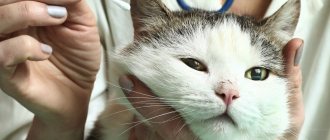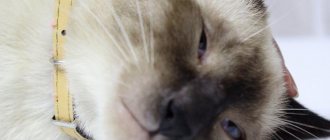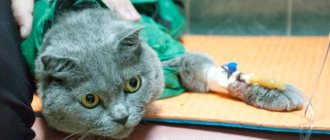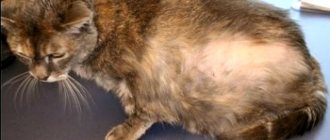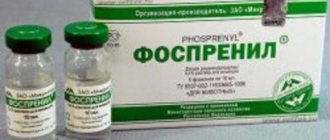9806Administration
Bald patches above the eyes in cats occur as a result of allergies, fleas or ticks, malnutrition, diabetes, thyroid pathologies, and dermatomycosis. Baldness in the eye area is a characteristic sign of subcutaneous demodex mites.
If you notice a receding hairline in the area of the eyes and ears in a cat, you must urgently contact a veterinarian for an examination, diagnosis and prescription of an effective therapeutic course.
© shutterstock
The appearance of receding hairline: reasons
The disappearance of hair above the eyes or near the ears is called alopecia, and in common parlance, a receding hairline. In fact, there can be quite a lot of reasons causing this pathology. Let's look at the main ones.
The main causes of bald spots in cats:
- Allergy. Allergic reactions in cats are very common. The main factors that cause allergies are food (lamb, cereals, plant and animal proteins, low-quality feed), pollen, house dust, mold, and some medications.
- Hormonal disorders. Often the cause of bald spots is a pathology of the endocrine system, in particular, a disorder of the adrenal glands, acromegaly, problems with the functioning of the internal glands, diseases of the thyroid gland (hypothyroidism), diabetes mellitus, as well as post-castration syndrome (in this case, bald spots appear in the animal’s neck area ).
- Fleas. This variant is almost never found in domestic cats. But if suddenly you notice that your cute kitten has suddenly begun to actively itch, then it is better to carefully examine it and, of course, treat it with a special flea remedy.
- Fungus. One of the rather unpleasant causes of baldness in cats is dermatophytosis. With this pathology, areas of baldness appear near the eyes, ears, and tail. They are characterized by flaking, the appearance of inflammatory papules, and the areas of hair around the flaky patches are often broken off. This disease is quite contagious and can be transmitted to other animals, as well as to its owners.
- Scabies, lichen. With scabies and lichen, in addition to small bald spots and bald spots, the pet will experience severe itching.
- Stress. It may seem surprising, but our pets often experience stress and even depression. In this case, you will need to take a closer look at your pet and eliminate the reasons that caused this pathology. This could be a change of environment, place of residence, change of food.
- Malignant and benign formations. Recently, in connection with artificial feed, a large number of neoplasms have begun to be diagnosed. Hair loss is just one of the manifestations of this pathology.
Bald patches near the ears
The appearance of bald spots near the ears, or they are also called periauricular alopecia, is associated with the same reasons that cause all other types of baldness. Most often, this pathology occurs in short-haired cats. It is almost always characterized by only one symptom—the formation of small bald spots near the ears. The main reason is a change in food and a lack of vitamins.
Bald patches near the ears.
The cat has bald patches and sores above the eyes
There are many factors to consider when discovering bald spots in the eye area. Sometimes this pathology can be caused by conjunctivitis and sweat gland cysts. In this case, ulcers, redness, and slight weeping appear in the area around the eyes. As a result, the hair follicles are affected, which leads to hair loss in the animal. In this case, you should immediately contact your veterinarian. Also, other causes such as allergies and lack of vitamins should not be excluded.
Bald patches near the eyes.
Why does baldness occur?
There are many factors that provoke the manifestation of alopecia. Most often, this phenomenon occurs in short-haired cats. Before moving directly to the treatment of pathology, it is necessary to understand what caused the disease. The most common cause of a receding hairline is food allergies. Most often, cats are allergic to foods such as lamb, cereals, and proteins of plant or food origin. By adjusting your pet's diet, you can improve its health.
Hormonal imbalance can also cause the formation of bald spots in a cat. In this case, hair falls out not only in the ears or around the eyes, but also in other areas. With hormonal imbalance, baldness occurs in the abdomen, chest, hind legs, armpits, and also in the area near the anus.
Stress can trigger baldness in cats. When the cause of a skin disease is a psychogenic factor, the cat may also begin to lose hair in the abdomen, thighs and inner surface of the paws. In this case, the owner needs to provide his pet with the most peaceful living environment possible. Calming medications intended for cats will also have a beneficial effect on the health of your four-legged friend.
Alopecia sometimes results from dermatomycosis. In this case, increased hair loss is noticed in the area of the eyes and ears. The shape of bald patches with dermatomycosis has a ring-shaped or rounded shape. In problem areas, the skin is quite dry, however, the cat is not bothered by itching. The cause of the development of dermatomycosis is fungal diseases that negatively affect the epidermis and fur of the pet. Treatment of bald patches in cats is carried out using special antifungal agents.
You might be interested in: Why does a Sphynx get spots on her skin?
What to do if you find bald spots?
Immediately show the animal to a veterinarian. You should not engage in treatment and find out the causes on your own. It is best to entrust the health of your pet to a specialist. At the veterinary clinic, they will carefully question you about your pet, do a thorough examination, prescribe a specific and general blood test, take a scraping of the epidermis, microbiological examination of the roots of the animal’s fur, and if there is a suspicion of a neoplasm, they will do an ultrasound or x-ray. Depending on the results of the examination, appropriate treatment will be prescribed.
At the veterinarian's appointment.
If the reason is in the diet, then they will definitely prescribe a change in food, it will be necessary to remove lamb, cereals, cereals, proteins of plant and animal origin from the diet, and prescribe vitamins.
no, no, no, darling!
We remove lamb and animal proteins from the diet.
If you have an allergy, you need to exclude the allergen and prescribe antihistamines.
If the cause of baldness is stress, then sedatives are prescribed.
Inflammatory formations are treated by treating the skin with antiseptics and antibiotics.
In case of scabies, fleas, lichen or fungus, the doctor prescribes specific treatment.
For neoplasms, the tactics are decided by the doctor individually, depending on the stage of the disease.
How to help a cat whose ears are going bald
After determining the cause, the cat owner will have to strictly follow the veterinarian's recommendations . Any deviation from the planned treatment plan is fraught with complications.
If baldness is caused by dermatitis caused by allergies, then you will have to part with even your favorite hyacinths, lilies and other potentially dangerous plants. Their list is not that long. This includes all types of euphorbia, indoor chrysanthemum, hippeastrum, sansevieria, clivia, primrose, poinsettia.
The medicine that caused baldness should be stopped immediately and special attention should be paid to its composition. It is likely that the irritation was caused by one component, and not their complex. Therefore, be careful when giving your pet all other medications with a similar composition, and ideally, their use should be supervised by a veterinarian. It is possible that the baldness was caused by food, in which case the veterinarian will prescribe a diet consisting of specialized foods. Many cat owners neglect it, and after a while a relapse occurs, i.e. after a short-term improvement, the cat begins to go bald again. To exclude this possibility, you need to give your pet only hypoallergenic food recommended by a veterinarian.
Bacterial infections can only be treated with antibiotics, and to get rid of the virus you will have to follow a whole set of rules. It includes diet, filling the animal’s diet with certain groups of vitamins, and the use of medications.
To eradicate the cause of the disturbance in the animal’s mental balance, you will also have to resort to the help of tablets , although in this case these will be mood modifiers and tranquilizers.
How to distinguish normality from pathology?
In some cases, hair loss is not associated with pathological causes.
- Pregnancy in cats. The appearance of bald patches can occur in cats that have given birth before birth. During the feeding period, the cat experiences stress and a lack of vitamins and nutrients.
Feeding period in cats.
- Hereditary factor. Unlike the previous reasons, this does not occur as often. But if your cat’s parents had problems with hair loss, then there is a chance that your pet may also have this problem.
- Shedding. Everyone knows that in the autumn-spring periods the fur of animals is renewed. This phenomenon is absolutely normal and there is no need to sound the alarm.
Shedding in cats
- Age. The older your pet gets, the thinner and thinner its coat becomes. In the future, baldness may appear near the ears and around the eyes.
- Change in hormonal levels. The appearance of bald spots in this case occurs due to hormonal drugs that suppress sexual activity in cats.
Common diseases leading to baldness
0 Source:
If the functioning of internal organs is disrupted, the disease can manifest itself through baldness. However, hair loss is not the worst symptom.
- Hyperthyroidism. Malfunctions of the thyroid gland together with increased levels of hormones lead to the fact that the cat’s hair will fall out even from light stroking. Associated symptoms are thirst, frequent urination, and enlarged peritoneum.
- Worms. If there is a large number of parasites in a pet, the metabolic process is disrupted and the immune system is suppressed. One of the first signs of infestation is dull hair that falls out due to lack of nutrients. In severe cases, patches of baldness appear.
Prevention
In order not to worry about baldness in the future, it is necessary to regularly follow preventive measures.
- Remove cheap, low-quality, fatty food from your pet.
- Carry out vitamin therapy at least twice a year.
Vitamin therapy in cats.
- Keep dishes clean. Ceramic, glass and iron bowls are best for cats.
- Timely vaccination.
- Periodic examination by a veterinarian.
- Maintain cat hygiene.
Experts recommend not to ignore routine examinations by veterinarians!
Signs of pathology
Alopecia is an anomaly that occurs due to a malfunction in the body and requires medical intervention. Large bald areas and bald spots on the pet's body should alert the owner.
Signs of pathology:
- severe hair loss during scratching and walking;
- the hair falls out in clumps, leaving bald areas in the area of the ears, back, tail and other parts of the body;
- the hair on one side is thicker than on the other;
- the skin on bald areas is not pinkish, as it should be normally, but red;
- peeling, ulcers, wounds and scabs are noticeable on the skin;
- the animal scratches the bald spot vigorously, possibly to the point of bleeding;
- touching the skin causes anxiety in the cat or, conversely, apathy.
If you notice one or more of the listed symptoms in your pet, take immediate action.
Remember that timely treatment is much more effective than therapy in severe stages of the disease.
Description of possible causes
If your cat is balding around the eyes, the skin in these places is red and inflamed, then you should not put off a visit to the veterinarian, since very often such symptoms are complicated by severe itching, which leaves large scratches. And open wounds are always considered potentially dangerous, since infection can penetrate through them. Given that the lesions are located near the organs of vision, the following possible causes of hair loss in this area should be considered:
Food allergies. The most common cause of baldness around the eyes in cats. Incorrectly selected food, especially in cases with decorative breeds, can cause a lot of trouble. That is why veterinarians around the world urge you not to skimp on your pet and choose food based on its needs, not price. The results of such savings will not be long in coming. In the best case, the animal’s fur will become dull and fall out in different places. At worst, peeling and redness of the skin, severe itching and rashes may appear. Sometimes the problem can be solved by simply changing the food, but not in the case of decorative breeds (Maine Coon, Bobtail, Sphinx). They may require maintenance therapy and symptomatic treatment during exacerbations throughout life.- Bacterial damage. Very common in the area of the brow ridges. May be provoked
be an allergy, lichen or demodicosis. At the initial stage, black specks appear under the fur, and as the process progresses, the area around the eyes becomes bald and redness appears. A distinctive feature is a terrible itch, due to which the cat literally tears itself apart. Treatment is primarily aimed at finding and eliminating the cause that provoked the pathological growth of bacteria. To confirm the diagnosis, scrapings until blood is drawn from the affected areas are taken for cytological examination. In most cases, one of the types of Staphylococcus is found. The treatment regimen depends greatly on the severity of symptoms. In some cases, antibiotic therapy lasts at least 3-5 weeks; in addition, special antibacterial shampoos are used during bathing. In no case should you ignore or neglect bacterial skin lesions, as the process can be complicated by the appearance of large ulcers or fistulas, which take several months to heal. - Demodecosis. Not the most common disease in cats, but it does occur. It mainly affects the muzzle and the flexor part of the limbs. A distinctive feature is the absence of itching. But, in
If the lesions are localized on the face, the area becomes bald around the eyes, redness of the skin and small black rashes appear. It can be complicated by a bacterial infection, which will lead to itching and severe scratching. Demodectic mange necessarily provokes something; the mite itself cannot reproduce pathologically. Usually this is long-term use of antibiotics (which could provoke a decrease in the body’s protective functions), allergies, oncology or severe stress. Based on this, we draw your attention to the fact that there is no point in treating demodicosis symptomatically if the underlying disease that provoked it is not eliminated or brought under control. - Lichen. It may appear in the muzzle area in the form of small lesions. Accordingly, baldness around the eyes of a cat may well be caused by a fungal infection. In this case, the accompanying symptoms include peeling and the appearance of a red rim around the bald spot. Itching is not always present. You can become infected with lichen without even going outside, since fungal spores often get onto the pet’s fur from the soles of the owner’s shoes, after using someone else’s objects (carrying, collar, clothes, comb, etc.). To confirm the diagnosis, hair and scales must be taken for microscopic examination and deep tweezers for cytology. Additionally, a Wood's fluorescent lamp can be used, under the glow of which the wool affected by fungi will have an emerald hue. The treatment is complex with mandatory isolation of the animal, as there is a risk of infection not only to other pets, but also to people living in the house. Oral medications (itraconazole), ointments (fungin) and bathing shampoos (nizoral) can be used as treatment.
Overview of Possible Causes
You need to start with the fact that in rare cases, bald patches above the eyes of a cat can be caused by natural causes - shedding. But then there will be no accompanying symptoms, and most importantly, itching. The fur in this area will grow within a few weeks. In all other cases, it is necessary to exclude the following possible causes and pathologies to make a correct diagnosis:
- Scratching. After scratching, a cat develops bald patches above the eyes if the itching is caused by conjunctivitis, allergies or a bacterial infection. An alarming sign is when your pet scratches the eye area with its paws more than usual. Particularly dangerous are cases when scratching leaves open wounds. They can become infected. Scratching can only be dealt with by eliminating the cause that triggered its occurrence. After this, the balding areas disappear within 2-3 weeks.
- Eosinophilic granulomas. Along with bald patches above the eyes, the cat develops red sores, which are accompanied by severe itching. Single formations can go away on their own within 1-2 months. For eosinophilic granulomas, it is recommended to change food and utensils (plastic is replaced with ceramics or glass). In severe cases, hormonal therapy is used, which is selected individually for each animal.
- Dermatophytosis. The most common cause of bald spots above the eyes in cats. Characteristic signs also include peeling of the skin inside the lesion, the appearance of pink papules and dry crusts. The hair around the formation of spots is often broken off. There are also many known cases of asymptomatic disease. It should be remembered that dermatophytosis is a highly contagious pathology. It can be transmitted not only to other animals, but also to people living in the same house with an infected pet. Despite this, dermatophytosis is prone to self-destruction. To make a diagnosis, it is necessary to carry out a number of diagnostic measures, including microscopic examination of crusts taken from bald areas of the body, glowing of bald patches under a Wood's fluorescent lamp and culture. The first two analyzes are carried out most often, the second is much more informative, but you have to wait 2-3 weeks for the result. In 80% of cases, the fungus Microsporum Canis is detected. Treatment is long-term with the use of systemic drugs in combination with medicated shampoos. The most commonly prescribed are Itraconazole, Fungin, Nizoral and Terbinafine. For disinfection, chlorine-containing agents are used to wipe and treat surfaces where fur with spores may remain. Particular attention is paid to the animal's sleeping place.
- Allergy. It can be triggered by various factors, ranging from ingestion of the allergen (introduction of a new product into the diet or incorrectly selected food) or close contact with it (plastic bowl, woolen clothing or bedding). For food allergies, a method of elimination is used to try to determine the food to which the animal is sensitive. If this cannot be done, then hypoallergenic food and symptomatic treatment are prescribed. Atopic dermatitis is even more difficult to diagnose, since the allergen can be house dust or pollen from plants growing near the house. It occurs mainly in decorative breeds; treatment in most cases is lifelong during the period of exacerbation. Anti-inflammatory drugs and antihistamines are used as treatment.
- Flea dermatitis. A distinctive feature is severe itching, due to which the cat tears the skin until it bleeds. In these places, large bald patches appear, inside which there is inflamed skin and dry crusts. Common locations for lesions are above the eyes, behind the ears, stomach and sides. Even if, after a careful inspection, the owner does not find a single flea, this does not mean that they do not exist. Or even worse, the bite of even one parasite can provoke a severe allergic reaction to her saliva. In any case, it is recommended to treat all cats and dogs living in the same house with Stronghold or Frontline, which are applied to the withers 2 times every 15 days.
